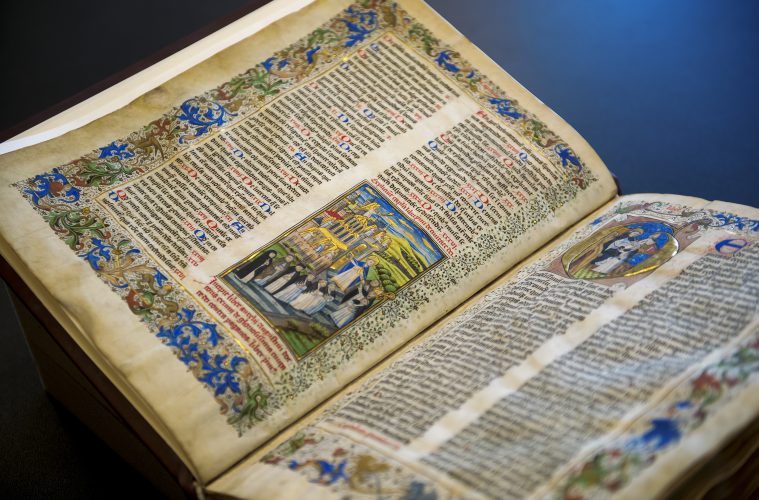On a crackly fall day, the Northeast Document Conservation Center (NEDCC) in Andover was buzzing with staff members returning old—and even ancient—paper-based artifacts to a time before human folly and the world’s elements had wreaked their damage.
Todd Pattison, senior book conservator, was showing a newly rebound 15th-century document—its Latin text hand-lettered on parchment and illuminated in gold leaf—owned by a large institutional library. Wallpaper for a historic house was being reproduced from a dingy remnant under the watchful eye of Terrance D’Ambrosio, director of imaging. Several staff members, including Michael Lee, the director of paper and photograph conservation, were unveiling an enormous bird’s-eye view photo of Andover, marred by the small fingers of children who had scratched into its surface, to assess its repair. (For security reasons, the NEDCC doesn’t reveal ownership of its projects while they are still in-house.)
Other NEDCC staff members were repairing precious artwork, reproducing historic photos, and preparing assessments and trainings for individuals and institutions on how to better care for their collections.
Bill Veillette, executive director of NEDCC, says that the hundreds of projects his 40-member staff work on each year are treated with equal care. That’s not to say that some projects don’t have a special edge of intrigue.
“We do lots of projects that are very important,” Veillette says. Recently, the staff was asked to repair and preserve several copies of the Declaration of Independence, which were sent throughout the Colonies to be read on public commons in the 1700s. “Not many of these survived,” Veillette says. “But the few that [did] are very rare and very important. We’re excited to do them.”
Staff had just finished conserving Woody Guthrie’s scrapbooks, after the American singer-songwriter’s daughter, Nora Guthrie, asked the NEDCC to help her with an archive of her dad’s work, now based in Oklahoma. “She spent about a year deciding whom she would trust to work with them before coming here,” Veillette says. “These are the kinds of things our conservators get really excited about. Every day is fun; there’s something new every day that comes in for us to evaluate.”
The NEDCC, founded in 1973, is the country’s first independent conservation laboratory to specialize in conserving and preserving paper-based collections. The items can be as unassuming as a register from a hotel in Hawaii. But this particular project, still being assessed, is a register from the 1800s, where hotel guests describe erupting volcanoes, along with the occasional line drawing and clips of yellowed newspaper articles. The history here is deep, visceral, and always intriguing.
The NEDCC’s enormous space is filled with equipment that has an intimidating high-tech look, but the work here is actually very hands-on, with conservators using hand brushes and scalpels for many of their tasks. Every attempt is made to preserve the history of the artifact, stabilizing it so it lasts for future generations. For instance, the imaging lab uses flash photography to protect the object from harsh lighting, common in scanners.
When the Appalachian MountainClub (AMC), based in Boston, wanted to learn how to store its thousands of images that chronicle outdoor life in the United States from the 1870s to the present, AMC librarian and archivist Becky Fullerton approached the NEDCC, with funding from the National Endowment for the Humanities. “Everyone loves historical photograph collections,” Fullerton says. “They’re so mesmerizing. You can never get enough.” In one photo, mysteries and questions arise like little ghosts. A group of men and women, recreational trekkers, were photographed ascending Mount Adams in 1893. Labeled “Camp Party at the Perch, Mount Adams, New Hampshire, 1893,” the photo shows women dressed in long, billowing skirts, with fancy hats and handbags; the men beside them are in coats and ties. Who are these people, and how did they ever manage this kind of a climb?
NEDCC senior photograph conservator Monique Fischer, who headed the project, was thinking about the photographers who recorded these feats, and who likely had to carry tripods among their equipment. In times not much earlier than the photo of the mountain climbers was shot, photographers also were lugging heavy glass-plate negatives up mountains, along streams, and any other place they had to go to get their shot.
“You had to carry your darkroom with you and develop negatives right away,” Fischer says. “It wasn’t for the faint of heart. It wasn’t easy to do. That’s what kind of amazes me.”

